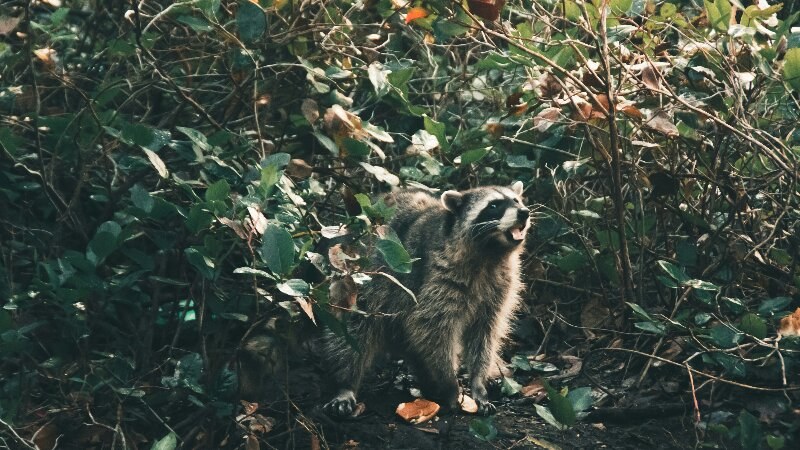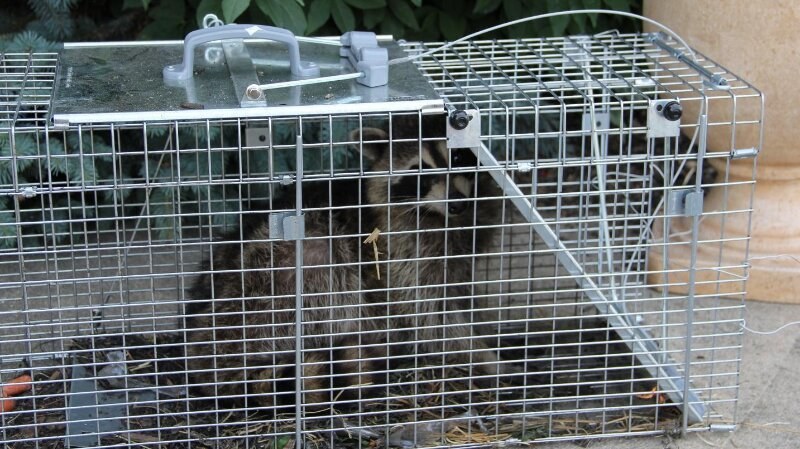Wildlife Control in Winnipeg - Signs You Have a Raccoon in Your Yard & How We Get Rid of It
Reading time: 7 minutesImagine stepping into your backyard. You take a deep breath enjoying the crisp air only for your eyes to notice trash scattered around your garden. As you look closer, you see a pair of mischievous eyes gleaming back at you from the shadows.
This isn’t just a nonchalant encounter with wildlife – it’s the sign of a raccoon making itself at home on your property. Raccoons, with their dexterous paws and curious natures, are not as lovable as Rocket Raccoon. They present a real challenge in urban settings like Winnipeg.
It’s essential to know how to address wildlife conflicts, not only to safeguard your homes but also to ensure the safety and health of both humans and animals.

Signs You Have a Raccoon Living In Your Yard
Raccoons are clever creatures, but they leave a series of unmistakable signs that can alert any
- Overturned garbage bins. Raccoons have nimble fingers and strong forepaws, which they use expertly to pry open lids in search of food. If you find your trash cans knocked over or the lids removed, a raccoon might be the culprit.
- Uprooted garden. If you find your garden uprooted or patches of sod rolled back, it’s often a raccoon’s handiwork as they dig for worms or grubs. Raccoons may also dig up plants, tear up lawns in search of grubs, or feast on fruits and vegetables from your garden.
- Raccoon tracks. Raccoon footprints are distinctive, with five toes on both the front and hind feet resembling tiny human hands. These might be visible in the soil of your garden, in mud, or in snow.
- Unusual noises at night. If you hear rustling and thumping noises coming from your shrubbery, attic or crawlspace during the night, it’s likely a raccoon. These sounds are typically more pronounced after dark since raccoons are nocturnal.
- Damage to pet food storage. Raccoons are attracted to pet food. If you notice torn bags or scattered pet food, it could be a sign of raccoon activity.
- Grease marks. Raccoons often leave greasy, dark marks along the paths they travel and at entry points they use frequently. These marks are created by the oil in their fur and can be a clear sign of regular visits.
- Feces. Raccoons often leave their feces in communal sites called latrines. Identifying these can help pinpoint raccoon presence and activity areas.
- Nests or dens. Raccoons often create dens in hollow trees, attics, chimneys, or under decks. If you notice a new, unusual hole or nesting site, it might be a raccoon's new home.
- Damage to structures. Raccoons are strong climbers and can damage fences, siding, or roof shingles while trying to enter your home or other structures.
- More than One Sighting. Of course, the most obvious sign is actually seeing a raccoon in your yard, especially at dusk or dawn. You probably don’t have much to be concerned about if you’ve seen one once and not a peep in the next few weeks; it could be an isolated incident. However, if you’ve seen a raccoon more than once in the same week, this may be a sign of the little guy sticking around.
Raccoon Behaviour
Behavioural Traits
Raccoons are primarily active at night, which explains why most signs of their presence are discovered in the morning. Their nocturnal activities are mostly driven by the search for food. Raccoons are opportunistic feeders, and their diet in urban areas can include anything from fruits and insects to pet food and garbage.
These animals are highly adaptable and can make their dens in a variety of locations, from hollow parts of trees to attics and under decks. This adaptability, paired with their intelligence, makes raccoons fascinating yet challenging wildlife neighbours.
The proximity of human habitats provides them with easy access to food and shelter, but it also brings them closer to risks such as traffic and potential conflicts with pets and humans. Understanding this can help us anticipate and mitigate potential encounters or conflicts.
Why Should You Be Careful Around Raccoons?
Raccoons might look harmless enough, but they bring a host of potential risks into your backyard. Firstly, some of them are known carriers of diseases like rabies, which can pose a serious health threat to humans and pets alike. Rabies is transmitted through bites or scratches, making any direct encounter with a raccoon risky.
Additionally, raccoons can carry and spread other zoonotic diseases, such as leptospirosis, which is transmitted through their urine and can contaminate water sources or soil.
Beyond health risks, raccoons are curious and determined creatures, which often leads them to cause significant damage in their quest for food or a cozy nesting site. They can tear through roof shingles, gnaw on wooden beams, displace insulation, and even chew through electrical wires, posing fire risks and expensive repairs.
Their dexterity allows them to open latches, turn doorknobs, and undo screws, often leading to unexpected and costly damage to property. Their search for food can also lead them to raid bird feeders, pet food containers, and garbage bins, creating a mess and attracting other pests.
Humane and Professional Raccoon Control

Humane Wildlife Live Trapping
Live trapping is a preferred method for handling raccoon invasions ethically. As professional wildlife control experts, we use specially designed live traps that do not harm the animal. These traps are placed strategically near known raccoon paths or feeding sites, baited with food that is appealing yet not harmful to raccoons, such as fruits or marshmallows. The placement must be away from high human traffic yet accessible enough for the raccoon. The goal is to capture safely, not to stress or injure the animal during the process.
Legal and Safe Relocation
Relocating wildlife, including raccoons, is bound by specific state and local wildlife laws. Our team knows all about regulations, which dictate how far an animal must be relocated and the types of habitats suitable for release.
The humane treatment of the raccoons during transport is paramount. They’re transported in secure, covered enclosures to minimize stress. Releasing a raccoon into a suitable habitat, far enough from urban areas to discourage return but dense enough to support its survival, is critical for both the animal's welfare and the prevention of future problems. This ethical approach ensures that the raccoon can continue its life with minimal human interference.
Exclusion Solutions
Once the immediate raccoon problem is addressed, professionals focus on long-term exclusion solutions to prevent future entries. This involves a thorough inspection of the home’s exterior to identify any potential entry points and recommend a course of action to prevent entry.
If you wish, we can then help connect you with a team that can come in and seal entry points with durable materials like heavy-duty wire mesh, metal flashing, or solid blocks that raccoons cannot chew through or remove. Additionally, experts might install vent covers and chimney caps to block access to common raccoon nesting areas.
So now that we’ve sorted the problem…
How To Keep Raccoons Away?
Here are some tips that come straight from our raccoon pros!
- Secure Your Trash Cans. Use animal-proof lids or bungee cords to secure garbage can lids. Raccoons have a keen sense of smell and are attracted to food scraps. Make sure that garbage is not only securely shut but also stored in a bin with a locking mechanism or weighted lid.
- Feed Pets Indoors. Avoid leaving pet food outside, especially overnight. Pet food is a major attractant for raccoons, and leaving it out can invite unwanted visitors to your yard.
- Remove Food Sources. Keep your yard free of fallen fruits, nuts, and birdseed. Regularly clean beneath bird feeders to remove any seeds that may attract raccoons. Consider switching to feeders that are less accessible to raccoons.
- Block Entry Points. Close off access to potential nesting sites such as attics, under houses, porches, and chimneys. Use sturdy materials such as metal flashing or hardware cloth to seal off these areas. Ensure that vents are covered with the appropriate grating.
- Use Motion-Activated Lights or Sprinklers. Raccoons are nocturnal and prefer to forage in the dark. Installing motion-activated lights or sprinklers can startle them and discourage return visits.
- Keep Your Yard Clean and Clutter-Free. Reduce hiding spots and nesting materials by keeping your yard tidy. Remove piles of debris, stacked wood, and dense shrubbery where raccoons may find shelter.

Don't Let Raccoons Crash Your Party
Ready to reclaim your backyard without raccoons turning it upside down? Contact Buzz Boss for a comprehensive wildlife control solution. Our team is equipped to assess and resolve your wildlife concerns swiftly and humanely.
Don’t wait until the raccoons send you RSVPs for their next shindig at your place – get an estimate today and enjoy the peace of mind that comes with expert service.
Serving Calgary, Edmonton, Red Deer, Regina, Saskatoon, and the Okanagan area, in addition to Winnipeg, we’re just a click away from fortifying your yard.

